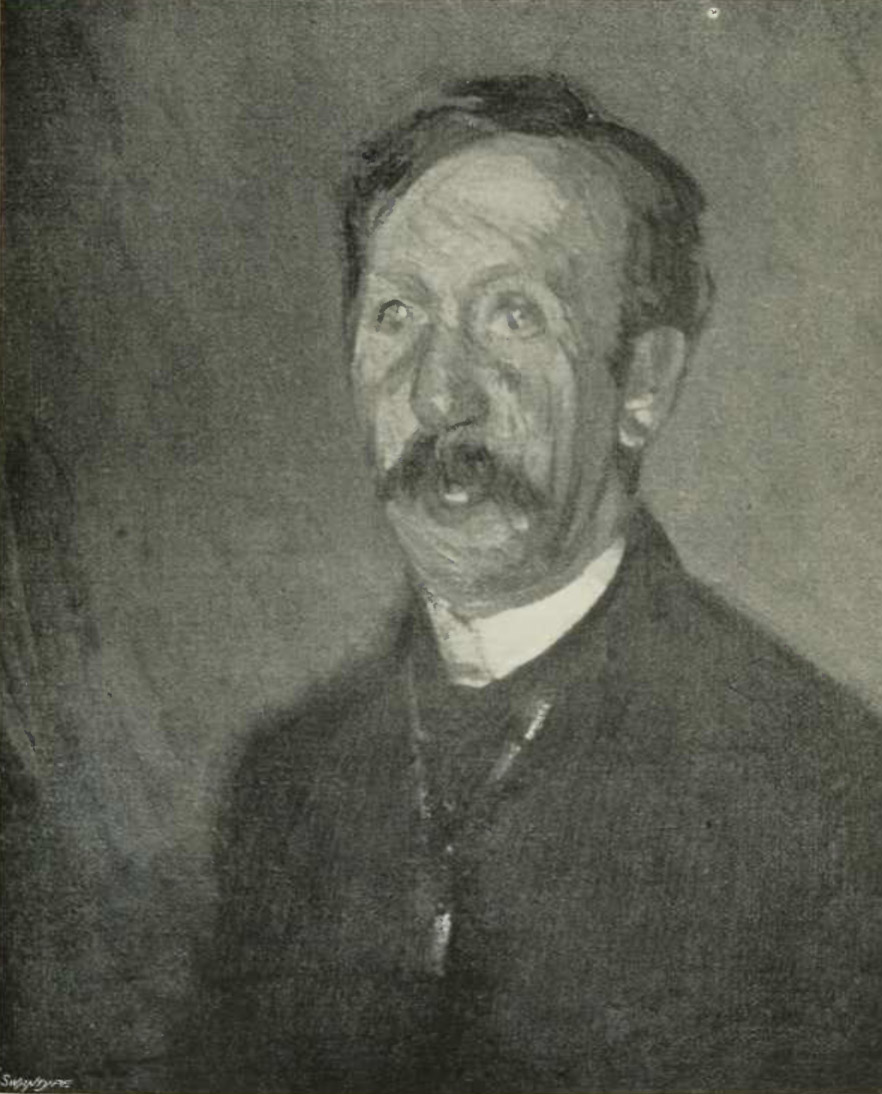George Moore
(1852 – 1933)
Born in County Mayo, Ireland in 1852, George Augustus Moore moved to London in 1869, where he spent much of his time painting and visiting art galleries. From 1873 to 1880, he lived in Paris and studied at l’Ecole des Beaux Arts and the Jullian’s Academy. There he became acquainted with many of the avant-garde painters and writers of the day, including Stéphane Mallarmé (1842-1898), Edouard Manet (1832-1883), Claude Monet (1840-1926), Edgar Degas (1834-1917), Camille Pissarro (1830-1903), Auguste Renoir (1841-1919), Alfred Sisley (1839-1899), and Emile Zola (1840-1902). Many of his Parisian experiences from this period are captured in his fictional autobiography Confessions of a Young Man (1888).
Although Moore loved painting, he soon concluded that he was unable to make a living as a visual artist and turned to writing. Influenced by Zola, Ivan Turgenev (1818-1883) and Gustave Flaubert (1821-1880), Moore introduced naturalism to the Victorian reading public. He was also influenced by Joris Karl Huysmans’s novel A rebours (1884), the central tome of the Decadent Movement. Starting his writing career with plays and poetry, Moore eventually turned to novels, his first two being the realist works A Modern Lover (1883) and A Mummer’s Wife (1885). The latter depicts a woman’s degradation through alcohol. Both novels were considered immoral, particularly for their frank depiction of sexual exploitation.
Moore’s novels were regularly banned from circulating libraries and only more daring publishers would deal with him. John Lane (1854-1925) was eager to publish Moore in The Yellow Book, as he knew that the novelist was about to release Esther Waters (1894), which became his most acclaimed novel. It depicted the struggle of an illiterate kitchen maid trying to raise her son and rise above various social and environmental circumstances. This novel was immensely popular and secured Moore’s future as a respected writer. His naturalism focused on the depiction of individuals as victims of external forces rather than as heroic agents.
While in London, Moore was on occasion a guest at the literary salon held at Lane’s office on Vigo Street. Among his friends at this time he counted Arthur Symons (1865-1945) and William Butler Yeats (1865-1939). Moore eventually moved back to Ireland and became a prominent figure in the Irish Literary Renaissance along with Yeats and Lady Gregory. He continued to publish and also collaborated with Yeats in founding the Abbey Theatre. He died in London in 1933.
© 2010, Ruth Knecthel
Ruth Knechtel completed her Doctorate at York University in Toronto. She has published in English Literature in Transition and Victorians Institute Journal. In addition, Ruth is in the process of building The New Woman Online, a searchable environment including rare documents related to the concept of nineteenth and twentieth century womanhood. Currently, she teaches at the University of Manitoba.
Selected Publications by Moore
- Aphrodite in Aulis. London: William Heinemann, 1930.
- The Apostle: A Drama in Three Acts. Dublin: Maunsel, 1911.
- The Bending of the Bough: A Comedy in Five Acts. London: T. Fisher Unwin, 1900.
- The Brook Kerith: A Syrian Story. Edinburgh: Riverside, 1916.
- Celibates. London: Walter Scott, 1895.
- Confessions of a Young Man. London: Swan Sonnenschein, Lowrey, 1888.
- Conversations in Ebury Street. London: William Heinemann, 1924.
- A Drama in Muslin. London: Vizetelly, 1886.
- Elizabeth Cooper: A Comedy in Three Acts. London and Dublin: Maunsel, 1913.
- Esther Waters. London: Walter Scott, 1894.
- Esther Waters: A Play in Five Acts. London: William Heinemann, 1913.
- Evelyn Innes. London: T. Fisher Unwin, 1898.
- Hail and Farewell, A Trilogy: Ave. London: William Heinemann, 1911.
- Hail and Farewell, A Trilogy: Salve. London: William Heinemann, 1912.
- Hail and Farewell, A Trilogy: Vale. London: William Heinemann, 1914.
- Héloïse and Abélard. London: Cumann Sean-eolais na h-Eireann, 1921.
- Hobbes, John Oliver, and George Moore. “The Fool’s Hour.” The Yellow Book, Vol. 1 (April 1894): 253-72. [First act of a comedy.]
- Impressions and Opinions. London: David Nutt, 1891.
- The Lake. London: William Heinemann, 1905.
- Lewis Seymour and Some Women. New York: Brentano’s, 1917.
- Literature at Nurse or Circulating Morals. London: Vizetelly, 1885.
- The Making of an Immortal: A Play in One Act. New York: Bowling Green, 1927.
- Memoirs of My Dead Life. London: William Heinemann, 1906.
- A Mere Accident. London: Vizetelly, 1887.
- Mike Fletcher. London: Ward and Downey, 1889.
- A Modern Lover. 3 vols. London: Tinsley Brothers, 1883.
- Modern Painting. London: Walter Scott, 1893.
- A Mummer’s Wife. London: Vizetelly, 1884.
- Parnell and His Island. London: Swan Sonnenschein, Lowrey, 1887.
- The Passing of the Essenes: A Drama in Three Acts. London: William Heinemann, 1930.
- The Pastoral Loves of Daphnis and Chloe. London: William Heinemann, 1924.
- Reminiscences of the Impressionist Painters. Dublin: Maunsel, 1906.
- Sister Teresa. London: T. Fisher Unwin, 1901.
- Spring Days – A Realistic Novel. London: Vizetelly, 1888.
- The Strike at Arlingford: a play in three acts. London: Walter Scott, 1893.
- The Talking Pine. Paris: Hours, 1931.
- Ulick and Soracha. London: Nonesuch, 1926.
- The Untilled Field. London: T. Fisher Unwin, 1903.
- Vain Fortune. London: Henry, 1892.
Selected Publications about Moore
- Frazier, Adrian. George Moore 1852-1933. New Haven, CT: Yale UP, 2000.
- Gilcher, Edwin. A Bibliography of George Moore. Dekalb: Northern Illinois UP,1970.
- —. Supplement to ‘A Bibliography of George Moore .’ Westport, CT: Meckler, 1988.
- Gray, Tony. A Peculiar Life: A Life of George Moore . London: Sinclair- Stevenson, 1996.
- Langenfeld, Robert. George Moore, An Annotated Secondary Bibliography of Writings about Him . New York: AMS, 1987.
- Skilton, David. Introduction. Esther Waters. By George Moore. New York: Oxford UP, 1983. vii-xxii.
- Stetz, Margaret D. and Mark Samuels Lasner. The Yellow Book: A Centenary Exhibition . Cambridge: Houghton Library, 1994.
MLA citation:
Knechtel, Ruth. “George Moore (1852-1933),” Y90s Biographies, 2010. Yellow Nineties 2.0, edited by Lorraine Janzen Kooistra, Ryerson University Centre for Digital Humanities, 2019, https://1890s.ca/moore_bio/.
